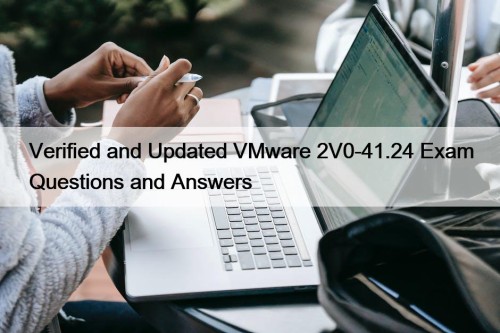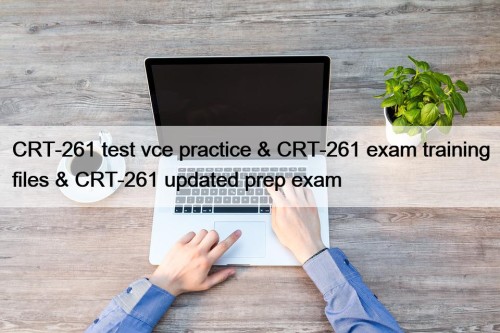Most Popular
 Three Main Formats of Pegasystems PEGACPLSA23V1 Exam Practice Material
Three Main Formats of Pegasystems PEGACPLSA23V1 Exam Practice Material
2025 Latest PassLeader PEGACPLSA23V1 PDF Dumps and PEGACPLSA23V1 Exam Engine ...
 Verified and Updated VMware 2V0-41.24 Exam Questions and Answers
Verified and Updated VMware 2V0-41.24 Exam Questions and Answers
Our 2V0-41.24 practice materials will help you pass the 2V0-41.24 ...
 CRT-261 test vce practice & CRT-261 exam training files & CRT-261 updated prep exam
CRT-261 test vce practice & CRT-261 exam training files & CRT-261 updated prep exam
2025 Latest TestkingPass CRT-261 PDF Dumps and CRT-261 Exam Engine ...



Verified and Updated VMware 2V0-41.24 Exam Questions and Answers

Our 2V0-41.24 practice materials will help you pass the 2V0-41.24 exam with ease. The industry experts hired by 2V0-41.24 study materials explain all the difficult-to-understand professional vocabularies by examples, diagrams, etc. All the languages used in 2V0-41.24 real test were very simple and easy to understand. With our 2V0-41.24 Study Materials, you don't have to worry about that you don't understand the content of professional books. You also don't need to spend expensive tuition to go to tutoring class. 2V0-41.24 test engine can help you solve all the problems in your study.
VMware 2V0-41.24 Exam Syllabus Topics:
| Topic | Details |
|---|---|
| Topic 1 |
|
| Topic 2 |
|
| Topic 3 |
|
>> Valid 2V0-41.24 Test Voucher <<
VMware Valid 2V0-41.24 Test Voucher Exam Instant Download | Updated 2V0-41.24 Latest Test Format
The product iPassleader provide with you is compiled by professionals elaborately and boosts varied versions which aimed to help you learn the pass your 2V0-41.24 exam by the method which is convenient for you. We check the update every day, and we can guarantee that you will get a free update service from the date of purchase. Once you have any questions and doubts about our 2V0-41.24 Exam Questions we will provide you with our customer service before or after the sale.
VMware NSX 4.X Professional V2 Sample Questions (Q32-Q37):
NEW QUESTION # 32
When configuring OSPF on a Tler-0 Gateway, which three of the following must match in order to establish a neighbor relationship with an upstream router? (Choose three.)
- A. Naming convention
- B. Subnet mask
- C. Area ID
- D. Address of the neighbor
- E. Protocol and Port
- F. MTU of the Uplink
Answer: B,C,F
Explanation:
according to the VMware NSX Documentation, these are the three parameters that must match in order to establish an OSPF neighbor relationship with an upstream router on a tier-0 gateway:
MTU of the Uplink: The maximum transmission unit (MTU) of the uplink interface must match the MTU of the upstream router interface. Otherwise, OSPF packets may be fragmented or dropped, causing neighbor adjacency issues.
Subnet mask: The subnet mask of the uplink interface must match the subnet mask of the upstream router interface. Otherwise, OSPF packets may not reach the correct destination or be rejected by the upstream router.
Area ID: The area ID of the uplink interface must match the area ID of the upstream router interface.
Otherwise, OSPF packets may be ignored or discarded by the upstream router.
https://www.computernetworkingnotes.com/ccna-study-guide/ospf-neighborship-condition-and- requirement.html
NEW QUESTION # 33
The security administrator turns on logging for a firewall rule.
Where is the log stored on an ESXi transport node?
- A. /var/log/vmware/nsx/firewall.log
- B. /var/log/fw.log
- C. /var/log/dfwpktlogs.log
- D. /var/log/messages.log
Answer: C
Explanation:
When logging is enabled for a firewall rule in NSX, the logs are stored on the ESXi transport node in the /var/log/vmware/nsx/firewall.log file. This file contains information about firewall rule hits and is useful for monitoring and troubleshooting firewall activity on the transport node.
NEW QUESTION # 34
Which of the following settings must be configured in an NSX environment before enabling stateful active-active SNAT?
- A. A Punting Traffic Group for the NSX Edge uplinks
- B. Tier-1 gateway in active-standby mode
- C. Tier-1 gateway in distributed only mode
- D. An Interface Group for the NSX Edge uplinks
Answer: D
Explanation:
To enable stateful active-active SNAT on a Tier-0 or Tier-1 gateway, you must configure an Interface Group for the NSX Edge uplinks. An Interface Group is a logical grouping of NSX Edge interfaces that belong to the same failure domain. A failure domain is a set of NSX Edge nodes that share the same physical network infrastructure and are subject to the same network failures. By configuring an Interface Group, you can ensure that the stateful services are distributed across different failure domains and can recover from network failures1
NEW QUESTION # 35
What is the VMware recommended way to deploy a virtual NSX Edge Node?
- A. Through the NSXUI
- B. Through the OVF command line tool
- C. Through the vSphere Web Client
- D. Through automated or Interactive mode using an ISO
Answer: A
Explanation:
Through the NSX UI. According to the VMware NSX Documentation2, you can deploy NSX Edge nodes as virtual appliances through the NSX UI by clicking Add Edge Node and providing the required information. The other options are either outdated or not applicable for virtual NSX Edge nodes.
https://docs.vmware.com/en/VMware-NSX/4.1/installation/GUID-E9A01C68-93E7-4140-B306-
19CD6806199F.html
NEW QUESTION # 36
What are two valid options when configuring the scope of a distributed firewall rule? (Choose two.)
- A. Segment
- B. Segment Port
- C. DFW
- D. Tier-1 Gateway
- E. Group
Answer: C,E
Explanation:
A group is a logical construct that represents a collection of objects in NSX, such as segments, segment ports, virtual machines, IP addresses, MAC addresses, tags, or security policies. A group can be used to define dynamic membership criteria based on various attributes or filters. A group can also be used as the scope of a distributed firewall rule, which means that the rule will apply to all the traffic that matches the group membership criteria32
NEW QUESTION # 37
......
Just download the VMware NSX 4.X Professional V2 (2V0-41.24) PDF dumps file and start the VMware NSX 4.X Professional V2 (2V0-41.24) exam questions preparation right now. Whereas the other two VMware NSX 4.X Professional V2 (2V0-41.24) practice test software is concerned, both are the mock VMware 2V0-41.24 Exam Dumps and help you to provide the real-time VMware NSX 4.X Professional V2 (2V0-41.24) exam environment for preparation.
2V0-41.24 Latest Test Format: https://www.ipassleader.com/VMware/2V0-41.24-practice-exam-dumps.html
- Exam 2V0-41.24 Topic 🧭 2V0-41.24 Best Study Material 💨 2V0-41.24 Passguide 🤰 Easily obtain [ 2V0-41.24 ] for free download through { www.actual4labs.com } 🎇2V0-41.24 Test Objectives Pdf
- Three Main Formats of VMware 2V0-41.24 Practice Test Material 🔥 Search for ➡ 2V0-41.24 ️⬅️ and download it for free immediately on “ www.pdfvce.com ” 🧘New 2V0-41.24 Test Question
- Realistic VMware 2V0-41.24 Questions with Multiple Offers 🐘 ➠ www.prep4away.com 🠰 is best website to obtain ➽ 2V0-41.24 🢪 for free download 🚃2V0-41.24 Test Objectives Pdf
- Valid 2V0-41.24 Test Voucher 100% Pass | Trustable VMware NSX 4.X Professional V2 Latest Test Format Pass for sure 🦒 Go to website ✔ www.pdfvce.com ️✔️ open and search for ➽ 2V0-41.24 🢪 to download for free 🕒Exam 2V0-41.24 Topic
- Latest 2V0-41.24 Dumps Pdf 🚜 Exam 2V0-41.24 Reviews 🐃 New 2V0-41.24 Test Question 🧈 Search for ⏩ 2V0-41.24 ⏪ and obtain a free download on ☀ www.getvalidtest.com ️☀️ 🅰Latest 2V0-41.24 Dumps Pdf
- 2V0-41.24 Latest Braindumps Ppt 🧄 2V0-41.24 New Braindumps Ebook ⬛ 2V0-41.24 Passguide 🦎 Search for ✔ 2V0-41.24 ️✔️ and easily obtain a free download on 「 www.pdfvce.com 」 😺Authorized 2V0-41.24 Pdf
- Pass Guaranteed 2025 Efficient VMware 2V0-41.24: Valid VMware NSX 4.X Professional V2 Test Voucher ⚒ Simply search for ➡ 2V0-41.24 ️⬅️ for free download on 【 www.torrentvalid.com 】 🐓2V0-41.24 Free Download Pdf
- VMware Valid 2V0-41.24 Test Voucher Are Leading Materials - Valid 2V0-41.24 Test Voucher: VMware NSX 4.X Professional V2 💖 Search for ▷ 2V0-41.24 ◁ and download it for free on ➤ www.pdfvce.com ⮘ website 📎2V0-41.24 Test Objectives Pdf
- Valid 2V0-41.24 Test Voucher | Professional 2V0-41.24 Latest Test Format: VMware NSX 4.X Professional V2 🔌 Search for ⏩ 2V0-41.24 ⏪ and download it for free immediately on ▶ www.real4dumps.com ◀ 🚑2V0-41.24 Free Download Pdf
- 2025 Unparalleled VMware Valid 2V0-41.24 Test Voucher Pass Guaranteed Quiz ⬇ Search for ➥ 2V0-41.24 🡄 and obtain a free download on ▶ www.pdfvce.com ◀ 📮2V0-41.24 Exam Questions Fee
- Valid 2V0-41.24 Test Voucher | Professional 2V0-41.24 Latest Test Format: VMware NSX 4.X Professional V2 💎 Search for ➽ 2V0-41.24 🢪 and download it for free immediately on ( www.free4dump.com ) 😊2V0-41.24 Valid Test Review
- 2V0-41.24 Exam Questions
- training.oraclis.co.za 追憶天堂手動服.官網.com ecourses.spaceborne.in glengre344.bligblogging.com codanics.com omg天堂.官網.com academy.laterra.ng bdlearn.com weecare.in 5000n-11.duckart.pro
Tags: Valid 2V0-41.24 Test Voucher, 2V0-41.24 Latest Test Format, Best 2V0-41.24 Study Material, New Guide 2V0-41.24 Files, New 2V0-41.24 Braindumps Questions